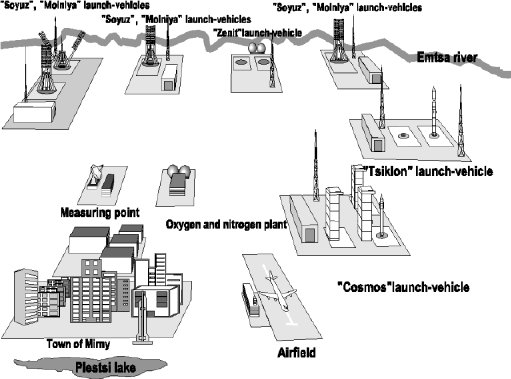

 |
 |
|
Plesetsk Cosmodrome

Plesetsk Cosmodrome
Plesetsk Cosmodrome is Russia's northernmost launch complex. Established in 1957, it was the world's busiest spaceport until the early 1990s; more than 1,450 rocket launches have taken place there since 1966. This total is greater than the combined totals from all other nations, estimated at more than one-third of all the world's orbital or planetary space launches. Until around 1993, over 50 launches were carried out per year at the cosmodrome. Despite a decrease in military satellite launches with the end of the Cold War, it still launches some 20 to 30 rockets annually. From November 11 1994, Plesetsk was designed as a “First State Testing Cosmodrome.” Plesetsk is located at 62.8 degrees north latitude in the Arkhangelsk region of Russia, about 400 miles northeast of St. Petersburg. Its northern latitude allows satellites to be launched into high inclination, polar, and highly elliptical orbits. The massive facility occupies more than 1,700 square kilometers. It includes six separate launch complexes and more than 11 launch pads. Some of the launch pads are similar to American launch pads where the booster is assembled on the launch pad and surrounded until launch by a moveable building or service structure. The service structure is 100 meters tall, covers 200 square meters, weighs 450 metric tons, and moves on rails. The nearby town of Mirny, a planned community, supports the facility, which is linked to the complex by train. Plesetsk originally functioned as a ballistic missile test range. With the start of military satellite launches from 1966, it became known as the Soviet Union's "northern cosmodrome." Rockets launched from Plesetsk have included the Kosmos 3M, Start, Soyuz, Molniya, Zenit, and Tsyklon 3. It delivers most polar-orbiting sensor payloads. An airfield, launch tracking center, and Europe's largest oxygen liquefaction plant are also located within the facility. The location of the site and the direction of launches from the site make it possible to keep the launch flight profile entirely over Russian soil during the boost phase of the orbit and reduce the requirement to coordinate launches with other countries. Because it is located inland, the lower, suborbital stages of boosters normally fall back onto its own territory. The facility began
as the world's first ICBM base in 1959, and construction of four massive launch
complexes began that year. Although it could launch ICBMs beginning in
1960, its first space launch did not occur until 1966. Plesetsk was chosen for the launch of polar-orbiting military
satellites in December 1962, when it became apparent that the Soviet Union's
other launch facility, Baikonur, was unsuitable for that purpose. The Soviet
government publicly admitted the launch
center's existence in 1983 after people in the area who were seeing rocket
launches repeatedly reported seeing unidentified flying objects. Western
journalists were admitted to the site in 1989, when they were told of two fatal
accidents at the site—one which occurred on June 26 1973, when nine technicians
were killed in a launch pad accident and a second on March 18 1980, when 50
technicians were killed by an explosion while fueling a Soyuz booster. |